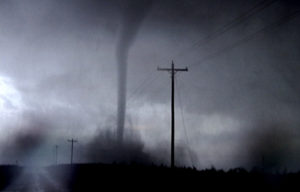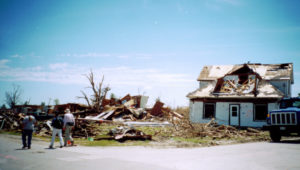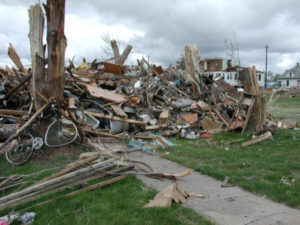Tornado Safety
Awareness Information – Remember storm chasing is not a safe activity. If there is a tornado warning for your area do not go out to chase the tornado. Many people have died trying to get a look at a tornado out of curiosity.
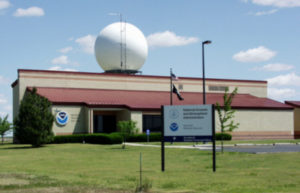
A National Weather Service WATCH is a message indicating that conditions favor the occurrence of a certain type of hazardous weather. For example, a severe thunderstorm watch means that a severe thunderstorm is expected in the next six hours or so within an area approximately 120 to 150 miles wide and 300 to 400 miles long (36,000 to 60,000 square miles). The NWS Storm Prediction Center issues such watches. Local NWS forecast offices issue other watches (flash flood, winter weather, etc.) 12 to 36 hours in advance of a possible hazardous-weather or flooding event. Each local forecast office usually covers a state or a portion of a state.
An NWS WARNING indicates that a hazardous event is occurring or is imminent in about 30 minutes to an hour. Local NWS forecast offices issue warnings on a county-by-county basis.
- Tornadoes may appear nearly transparent until dust and debris are picked up. Stay alert for high winds even if you do not “see” a tornado.
- Tornadoes often occur when it is not raining. In fact, in the Great Plains and other semiarid regions, that scenario is the rule rather than the exception. Tornadoes are associated with a powerful updraft, so rain does not fall in or next to a tornado. Very large hail, however, does fall in the immediate area of the tornado. In humid environments, rain often tends to wrap around the tornado, being pulled from the main precipitation area around the outside of the rotating updraft. The rain could make it difficult to see the tornado.
- Waterspouts are weak tornadoes that form over warm water and are most common along the Gulf Coast and southeastern states. In the western United States, waterspouts occur with cold late fall or late winter storms, during a time when you least expect tornado development. Waterspouts, which are tornadoes over a body of water, occasionally move inland becoming tornadoes and causing damage and injuries.
- Damage happens when wind gets inside a home through a broken window, door, or damaged roof. Keep windows closed. Houses do not explode due to air pressure differences. Stay away from windows during severe storms. Flying debris could shatter the glass and cause injury.
- It used to be advised to go to the southwest corner for safety; however, the southwest corner of a house is no safer than any other corner. Historical information has shown that any corner on the lowest level away from windows is as safe as any other corner. If tornado winds enter the room, debris has a tendency to collect in corners. When selecting a tornado “safe place,” look for a place on the lowest level and away from windows, preferably in a small room (closet or bathroom) in the center of the house. Closer walls will help provide more support to the roof, and each wall between you and the outside will provide further protection.
- Folklore passed down through the generations used to advise opening windows in case of a tornado because air pressure differences would cause a house to explode. This information is not true. Air pressure differences in a tornado are not strong enough to cause a house to explode; houses are damaged by the violent winds associated with a tornado and from the debris blown at high velocities by tornado winds.
- Folklore also used to advise that if you are driving and a tornado is suspected or sighted, you should turn and drive at right angles to the storm. This advice is not recommended because tornadoes do not necessarily travel in straight lines; you cannot always tell the direction the storm is coming from; the road you turn onto may curve and head into the storm, rather than away from it; and there may be more than one tornado associated with a strong storm system, but you may not see it because visibility is diminished by heavy rain and wind-blown debris. The safest thing to do is go to a nearby sturdy building and go inside to an area on the lowest level, without windows. If a sturdy building is not available, then get out of the vehicle and lay down in a low spot on the ground not subject to flooding, protecting the head and neck
Plan for a Tornado
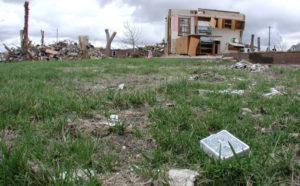
Develop a Family Disaster Plan. Tornado-specific planning should include the following:
- Learn about your tornado risk. While severe tornadoes are more frequent in the Plains States, tornadoes have happened in every state. Contact your local emergency management office, local National Weather Service office, or American Red Cross chapter for more information on tornadoes.
- Pick a safe place in your home where family members could gather during a tornado. The safest place to be is underground, or as low to the ground as possible, and away from all windows. If you have a basement, make it your safe place. If you do not have a basement, consider an interior hallway or room on the lowest floor. Putting as many walls as you can between you and the outside will provide additional protection. Less than 2 percent of all tornadoes are powerful enough to completely destroy a sturdy building. Make sure there are no windows or glass doors in your safe place and keep this place uncluttered.
- Consider having your tornado safe place reinforced. Additional reinforcement will add more protection from the damaging effects of tornado winds. Get more information from FEMA about building a tornado safe room.
- If you are in a high-rise building, pick a place in a hallway in the center of the building. You may not have enough time to go to the lowest floor. Center hallways are often structurally the most reinforced part of a building.
- If you live in a mobile home, choose a safe place in a nearby sturdy building. A sturdy building provides greater protection. If your mobile home park has a designated shelter, make it your safe place. Mobile homes are much more vulnerable to strong winds than site-built structures. Prior to 1994, most manufactured homes were not designed to withstand even moderate winds. Mobile homes are not safe in a tornado so have a sturdy building picked out ahead that you will go to if a tornado warning is issued.
- Discuss how you would be warned of an approaching tornado. Different communities have different ways of providing warnings. Many communities have sirens intended for outdoor warning purposes. Use a NOAA Weather Radio with a tone-alert feature to keep you aware of watches and warnings while you are indoors. Learn about your community’s warning system. Make sure all family members know the name of the county or parish where you live or are traveling, because tornado watches and warnings are issued for a county or parish by name.
- Learn about your community’s warning system. Different communities have different ways of providing warnings. Many communities have sirens intended for outdoor warning purposes, many have no sirens at all. Use a NOAA Weather Radio with a tone-alert feature to keep you aware of watches and warnings while you are indoors.
- Conduct periodic tornado drills, so everyone remembers what to do when a tornado is approaching. Practice having everyone in the family go to your designated area in response to a tornado threat. Practicing your plan makes the appropriate response more of a reaction, requiring less thinking time during an actual emergency situation.
- Check with your work and your children’s schools and day care centers to learn tornado emergency plans. Every building has different safe places. It is important to know where they are and how to get there in an emergency.
- Discuss tornadoes with your family. Everyone should know what to do in case all family members are not together. Discussing disaster ahead of time helps reduce fear and lets everyone know how to respond during a tornado.
- Keep your bike, motorcycle and rollerblade helmets in your safe area. This way when you have to take shelter the helmets are there waiting for everyone to put on.
What to Tell Children
- Find safe places in your home and classroom. Make sure these places are away from windows and tall furniture that could tip over. In your safe place, get under something sturdy, or use a large, hard-cover book to help protect your head and neck from flying or falling objects. Locate safe places outside in case you are not able to go inside. Frequently, children in schools are told to move to the inner hallways away from windows. Children need to know that a tornado safe place is not the same as a fire meeting place.
- Wherever you are, if you hear or see a tornado coming, take cover right away. Tornadoes can move quickly, blowing objects at very high speeds, even if they are a distance away. Protect yourself from flying debris by taking cover immediately.
- If you’re in a house or apartment building and a tornado threatens, go to the lowest level – a basement or storm cellar if possible. Once on the lowest level, go to the middle of the building away from windows, into a bathroom or closet if possible. The safest place to be is under the ground, or as low to the ground as possible, and away from all windows. If you have a basement, make it your safe place. If you do not have a basement, consider an interior hallway or room on the lowest floor. Putting as many walls as you can between you and the outside will provide additional protection. Make sure there are no windows or glass doors in your safe place and keep this place uncluttered.
- Get under something sturdy, such as a heavy table, hold on and stay there until the danger has passed. Being under something heavy will help protect you from falling objects. If tornado wind enters the room and the object moves, holding on with one hand will help you move with it, keeping you protected.
- Use your other arm and hand to protect your head and neck from falling or flying objects. Your head and neck are more easily injured than other parts of your body. Protect them as much as you can. If you have a bike, motorcycle or rollerblading helmets put them on your children.
- If you’re outside in a car or in a mobile home, go immediately to the basement of a nearby sturdy building. Sturdy buildings are the safest place to be. Tornado winds can blow large objects, including cars, hundreds of feet away. Tornadoes can change direction quickly and can lift up a car or truck and toss it through the air. Never try to out-drive a tornado. Mobile homes are particularly vulnerable. A mobile home can overturn very easily even if precautions have been taken to tie down the unit.
- If there is no building nearby, lie flat in a low spot. Use your arms and hands to protect your head. Tornadoes cause a lot of debris to be blown at very high speeds, and you can be hurt by this debris if it hits you. Dangerous flying debris can be blown under highway overpasses and bridges, or weaker overpasses and bridges could be destroyed. You will be safer lying flat in a low-lying area where wind and debris will blow above you. Tornadoes come from severe thunder- storms, which can produce a lot of rain. If you see quickly rising water or flood water coming towards you, move to another spot.
How to Protect Your Property
- Make a list of items to bring inside in the event of a storm. Having a list will help you remember things that may be broken or blown away in strong winds.
- Keep trees and shrubbery trimmed. Make trees more wind resistant by removing diseased or damaged limbs, then strategically remove branches so that wind can blow through. Strong winds frequently break weak limbs and hurl them at great speed, causing damage or injury when they hit. Debris collection services may not be operating just before a storm, so it is best to do this well in advance of approaching storms.
- Remove any debris or loose items in your yard. Branches and firewood may become missiles in strong winds.
- Consider installing permanent shutters to cover windows. Shutters can be closed quickly and provide the safest protection for windows.
- Strengthen garage doors. Garage doors are often damaged or destroyed by flying debris, allowing strong winds to enter. As winds apply pressure to the walls, the roof can be lifted off, and the rest of the house can easily follow.
Assemble a Disaster Supplies Kit
Disaster Supplies Kit Basics
The following items might be needed at home or for an evacuation. Keeping them in an easy-to-carry backpack or duffel bag near your door would be best in case you need to evacuate quickly, such as in a tsunami, flash flood, or major chemical emergency. Store your kit in a convenient place known to all family members. Kit basics are:
- A portable, battery-powered radio or television and extra batteries.
- Flashlight and extra batteries.
- First aid kit and first aid manual.
- Supply of prescription medications.
- Credit card and cash.
- Personal identification.
- An extra set of car keys.
- Matches in a waterproof container.
- Signal flare.
- Map of the area and phone numbers of places you could go.
- Special needs, for example, diapers or formula, prescription medicines and copies of prescriptions, hearing aid batteries, spare wheelchair battery, spare eyeglasses, or other physical needs.
If you have additional space, consider adding some of the items from your Evacuation Supplies Kit.
- A highway map to follow storm movement from weather bulletins.
- Disaster Supplies Kit basics.
Media and Community Education Ideas
- Publish a special section in your local newspaper with emergency information about tornadoes. Localize the information by printing the phone numbers of local emergency services offices, the American Red Cross chapter, and the nearest hospitals.
- Periodically inform your community of local public warning systems.
- Sponsor a “Helping Your Neighbors” program at your local schools to encourage children to think of those persons who require special assistance, such as elderly people, infants, or people with disabilities.
- Conduct a series on how to protect yourself during a tornado in case you are at home, in a car, at the office, or outside.
- Interview local officials about what people living in mobile home parks should do if a tornado warning is issued.
What to Do Before a Tornado
- Use a NOAA Weather Radio with a tone-alert feature to keep you informed of watches and warnings issued in your area. The tone- alert feature will automatically alert you when a watch or warning is issued.
- If planning a trip or extended period of time outdoors, listen to the latest forecasts and take necessary action if threatening weather is possible. Knowing what weather could happen helps you be prepared to respond if necessary. Having a raincoat, umbrella, and disaster supplies kit available will make it easier to deal with severe weather if it occurs.
- Watch for tornado danger signs. Tornadoes may happen so quickly warnings can’t be issued long in advance. Pay attention to weather clues around you that may warn of imminent danger.
- Dark, often greenish sky. Sometimes one or more of the clouds turns greenish (a phenomenon caused by hail) indicating a tornado may develop.
- Wall cloud, an isolated lowering of the base of a thunderstorm. The wall cloud is particularly suspect if it is rotating.
- Large hail. Tornadoes are spawned from powerful thunderstorms and the most powerful thunderstorms produce large hail. Tornadoes frequently emerge from near the hail-producing portion of the storm.
- Cloud of debris. An approaching cloud of debris can mark the location of a tornado even if a funnel is not visible.
- Funnel cloud. A visible rotating extension of the cloud base is a sign that a tornado may develop.
- Roaring noise. The high winds of a tornado can cause a roar that is often compared with the sound of a freight train.
- Tornadoes may occur near the trailing edge of a thunderstorm and be quite visible. It is not uncommon to see clear, sunlit skies behind a tornado. They may also be embedded in rain and not visible at all.
If you live in a single-family home in a tornado-prone area, find out how to reinforce an interior room on the lowest level of your home (such as the basement, storm cellar, bathroom or closet) to use as a shelter. Plans for reinforcing an interior room to provide better tornado protection in your home are available from your local emergency management office or from FEMA’s Surviving the Storm.
What to Do During a Tornado WATCH
- Listen to a NOAA Weather Radio or local radio or television stations for updated information. Tornadoes can change direction, intensity, and speed very quickly.
- Be alert to changing weather conditions. Tornadoes accompany severe thunderstorms, and weather conditions can change rapidly. Large hail, blowing debris, or the sound of an approaching tornado may alert you. Many people say approaching tornadoes sound like a freight train.
What to Do During a Tornado WARNING
- Listen to a battery-powered NOAA Weather Radio, regular radio, or television for updated information. If the electricity should go out, you will still be able to receive emergency information.
- If you are inside, go to your safe place to protect yourself from glass and other flying objects. Tornadoes can change direction, intensity, and speed very quickly. The tornado may be approaching your area.
- Get under a piece of sturdy furniture, such as a workbench or heavy table, and hold on to it. Sturdy furniture will help protect you from falling debris. If tornado wind enters the room and the object moves, holding on with one hand will help you move with it, keeping you protected.
- Use your other arm and hand to protect your head and neck from falling or flying objects. Your head and neck are more easily injured than other parts of your body. Protect them as much as you can. If you have a helmet put it on when you go to your shelter.
- Stay away from windows. Opening windows allows damaging winds to enter the structure. Leave the windows alone; instead, immediately go to a safe place. It is a myth that tornadoes cause houses to explode due to changes in air pressure. Flying debris can shatter glass. Violent winds and debris slamming into buildings cause most structural damage.
- If you’re outside in a car or in a mobile home, go immediately to the basement of a nearby sturdy building. Sturdy buildings are the safest place to be. Tornado winds can blow large objects, including cars and mobile homes, hundreds of feet away. Tornadoes can change direction quickly and can lift up a car or truck and toss it through the air; never try to out-drive a tornado. Mobile homes are particularly vulnerable. A mobile home can overturn very easily even if precautions have been taken to tie down the unit.
- If there is no building nearby, lie flat in a low spot. Use your arms and hands to protect your head. Tornadoes cause a lot of debris to be blown at very high speeds, and you can be hurt by this debris if it hits you. Dangerous flying debris can be blown under highway overpasses and bridges, or weaker overpasses and bridges could be destroyed. You will be safer lying flat in a low-lying area where wind and debris will blow above you. Tornadoes come from severe thunderstorms, which can produce a lot of rain. If you see quickly rising water or flood water coming towards you, move to another spot.
- Avoid places with wide-span roofs, such as auditoriums, cafeterias, large hallways, or shopping malls. Wide-span roofs are frequently damaged or destroyed in tornado winds, providing less protection and more risk of injury, than roofs over smaller rooms.
What to Do After a Tornado
- Continue listening to local radio or television stations or a NOAA Weather Radio for updated information and instructions. Access may be limited to some parts of the community, or roads may be blocked.
- Help a neighbor who may require special assistance – infants, elderly people and people with disabilities. Elderly people and people with disabilities may require additional assistance. People who care for them or who have large families may need additional assistance in emergency situations.
- Help injured or trapped persons. Give first aid where appropriate. Do not move seriously injured persons unless they are in immediate danger of further injury. Call for help.
- Watch out for fallen power lines or broken gas lines and report them to the utility company immediately. Reporting potential hazards will get the utilities turned off as quickly as possible, preventing further hazard and injury.
- Avoid disaster areas. Your presence might hamper rescue and other emergency operations, and put you at further risk from the residual effects of tornadoes.
- Stay out of damaged buildings. Tornadoes can cause great damage, creating further hazards. If you are away from home, return only when authorities say it is safe.
- When entering damaged buildings, use extreme caution. Moving through debris presents further hazards. Carefully watch every step you take.
- Wear sturdy shoes. The most common injury following a disaster is cut feet.
- Use battery-powered lanterns or flashlights when examining buildings. Battery-powered lighting is the safest and easiest, preventing fire hazard for the user, occupants, and building.
- Examine walls, floors, doors, staircases, and windows to make sure that the building is not in danger of collapsing.
- Look for fire hazards. There may be broken or leaking gas lines, or damage to electrical systems. Clean up spilled medicines, bleaches, gasoline, or other flammable liquids immediately. Fire is the most frequent hazard following other disasters.
- Check for gas leaks. If you smell gas or hear a blowing or hissing noise, open a window and quickly leave the building. Turn off the gas using the outside main valve if you can, and call the gas company from a neighbor’s home. If you turn off the gas for any reason, it must be turned back on by a professional.
- Look for electrical system damage. If you see sparks or broken or frayed wires, or if you smell burning insulation, turn off the electricity at the main fuse box or circuit breaker. If you have to step in water to get to the fuse box or circuit breaker, call an electrician first for advice. Electrical equipment should be checked and dried before being returned to service.
- Watch for loose plaster, drywall, and ceilings that could fall.
- Take pictures of the damage, both of the building and its contents, for insurance claims. Sometimes insurance companies can delay payment for tornado damages so policyholders who need help should be aware of their rights. Some claimants have to pursue legal action to get reimbursed for their tornado damage.
Much of the information in this article is from: Talking About Disaster: Guide for Standard Messages. Produced by the National Disaster Education Coalition, Washington, D.C., 1999.
